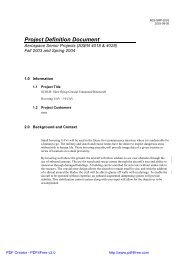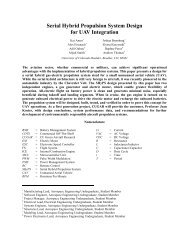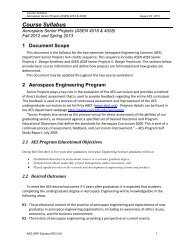PFR - Aerospace Engineering Sciences Senior Design Projects ...
PFR - Aerospace Engineering Sciences Senior Design Projects ...
PFR - Aerospace Engineering Sciences Senior Design Projects ...
Create successful ePaper yourself
Turn your PDF publications into a flip-book with our unique Google optimized e-Paper software.
Project Final Report – CUDBF April 30 th , 2009<br />
ASEN 4028: <strong>Aerospace</strong> <strong>Senior</strong> <strong>Projects</strong><br />
from the insertion of the rocket and restrain itself automatically. In order to release two stores<br />
from one servo, it was determined that one servo would control two pins by string. This would<br />
allow the servo to retract one pin which is experiencing the tension but the other pin would<br />
remain stationary since no load is applied through compression. The servo actuator would need<br />
to produce a torque equal to the spring constant times the gap width multiplied by the length of<br />
the servo arm. A concept of this can be observed in Figure 17.<br />
Figure 17: Preliminary Drawing of Tab-Spring Payload System<br />
5.2.1.3 Sliding Trigger <strong>Design</strong><br />
The sliding trigger design is based off of the coordinated movement of two pins to load and<br />
release the store. A tab with a hole is rigidly fixed to the store. To secure the store to the<br />
aircraft, this store-fixed tab is inserted into the bottom of the aircraft. As it slides in, it pushes<br />
against the rotating pin arm (seen in the figure below) which in turn rotates the release pin.<br />
Further insertion causes the rotating pin to rotate until it is perpendicular to the vertical store tab.<br />
At this moment, a spring will force the release pin back into its original position. This will<br />
prevent the rotating pin from coming back to its original position and the store will remain<br />
secured to the underside of the aircraft. To release the store, a servo actuator pulls the release pin<br />
out of its locked position and the weight of the store causes the rotating pin to rotate to its<br />
original position and release the store. A concept of this option can be seen in Figure 18.<br />
36
















